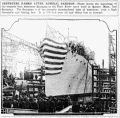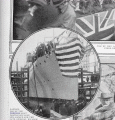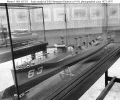Click On Image
For Full Size Image |
Size |
Image Description |
Contributed
By And/Or Copyright |

| 12k | Rear Admiral William T. Sampson, born at Palmyra, New York , February 9, 1840. Appointed to the United States Naval Academy September 24, 1857, and graduated at the head of his class in 1861. He subsequently earned an LLD degree from Harvard in 1899.
He was promoted to Master, 1861 and commissioned as a Lieutenant July 16, 1862. He was Executive Officer on the ironclad USS Patapsco when it was blown up by mine in Charleston harbor. He was blown into water, but then rescued. Advanced to Lieutenant Commander, July 25, 1866, Commander, August 9, 1874, Captain, March 1889. He was Superintendent of the Naval Academy, 1886-90. An expert on ordnance, torpedoes, etc. With Lieutenant Joseph Strauss, he devised-perfected superimposed turrets introduced into the Navy in February 1898. He was President, Board of Inquiry as to cause of the destruction of the USS Maine in Havana Harbor, February 15, 1898, and after a declaration of war with Spain he commanded the North Atlantic Squadron with the rank of acting Rear Admiral. Promoted to Commodore, 1898, Rear Admiral, 1899. During the Spanish-American his command numbered 125 vessels, the strongest ever organized for hostile purposes. His fleet captured many Spanish merchant vessels and blockade runners and finally defeated the Spanish fleet under Admiral Cevera. Appointed, September 1898, one of three commanders to Cuba. Resumed command of North Atlantic fleet, December 1898. Commandant, Boston USN Yard, Oct 14, 1899. In 1865-67 he served on the USS Colorado in European Squadron, advancing to Lieutenant Commander, July 1866. Again at USNA 1868-71, and, after service on the USS Congress in 1872 and European station in 1873 and promotion to Commander in August 1874, he returned for third tour, 1874-78, as head of Physics Department. 1879-82 he commanded USS Swatara in the Asiatic Squadron, after 2 years as Assistant Superintendent of the Naval Observatory in Washington, DC, during which time was delegate to International Prime Meridian Conference, October 1884, he commanded the Naval torpedo station at Newport from 1884 to 1886. September 1886 named Superintendent of the Naval Academy. Promoted to Captain in March 1889, he left the Academy in 1890 to command the USS San Francisco. 1893-97 he was Chief of the Bureau of Ordnance, where under his leadership much progress was made in such matters as introduction of smokeless powder and improvement of gunnery training. June 1897 given command of new battleship Iowa, joining the North Atlantic Squadron as senior Captain. During February-March 1898 served as president of the Naval Board investigating the sinking of the Maine in Havana harbor. In the latter month he was advanced to acting Rear Admiral, and named to succeed the ailing Montgomery Sicard in command of the North Atlantic Squadron. On declaration of war against Spain in April, he proceeded from Key West to institute a blockade of northern coast of Cuba, his own plan to attack Havana directly having been overruled by the Navy Department. In May while location of the Spanish fleet under Admiral Cevera was yet unknown, he made a cruise east to Puerto Rico and on May 12 bombarded San Juan. He then returned to blockade and joined by "Flying Squadron" under Winfield Scott Schley, who, though technically his senior, was placed under his command for the campaign. He sent Schley to reinforce the blockade of the southern coast, particularly at Cienfuegos and Santiago. Schley was tardy in movements, and Cevera slipped undetected into easily defended harbor at Santiago. When he was finally discovered there, Sampson concentrated his forces outside the harbor. He supported landing of Shafter's army at Daiquiri, June 22, and the capture of Siboney next day, and the subsequent advance to Santiago. Following capture of San Juan heights commanding the city on July 1 he and Shafter arranged a shore conference to plan a coordinated land-sea assault. On morning of July 3 aboard the USS New York, headed for the conference point some miles to east. Half an hour later the first of Cevera's ships appeared, steaming out of harbor to west. The Blockade Squadron, under the immediate command of Schley, went instantly into action and in less than 4 hours entire Spanish fleet was sunk or run ashore. The battle took place entirely to west of harbor entrance, and the New York was out of it altogether. Considerable controversy ensued, with Schley, who had been present aboard the USS Brooklyn, quickly becoming hero of day in papers, while the Navy Department and most knowledgeable observers credited Sampson's training, preparation, and standing orders with the squadron's success. A dispute, bitter at times, delayed promotions for both men for nearly a year. During September-December 1898 in Cuba as 1 of 3 US commissioners. He was made permanent Rear Admiral in March , and resumed command of his squadron until October 1899. He commanded the Boston Navy Yard until October 1901, waiting orders from then until hie retirement, February 1902. He died on May 6, 1902, at Washington, DC and it was originally suggested that he be buried at the Naval Academy. He was, however, subsequently buried in Section 21 of Arlington National Cemetery. | Steven A. Cardali |
 |
47k | USS Sampson (DD-63) slides down the ways at Fore River Shipbuilding in Quincy, Massachusetts on 4 March 1916. | Gerd Matthes |
 |
161k | Newspaper clipping from the Omaha Daily Bee, March 8 1916. | Mike Mohl |
 |
136k | Newspaper clipping from the New York Times, March 12 1916. | Michael Mohl |
 |
115k | USS Sampson (DD-63) underway at an unknown location circa 1916-1920. Source: Library of Congress, Photo No. LC-B2-3874-12. | Mike Green |
 |
148k | Photo NH 51829, USS Sampson (Destroyer # 63) at anchor in Hampton Roads, Virginia, 13 December 1916. U.S. Naval Historical Center Photograph. | Tony Cowart/Robert Hurst |
 |
58k | Photo NH 41781, USS Sampson (Destroyer # 63) anchored in Hampton Roads, Virginia, 13 December 1916. U.S. Naval Historical Center Photograph. | Robert Hurst |
 |
54k | Photo NH 41783, USS Sampson (Destroyer # 63) halftone reproduction of a photograph of Sampson in the Atlantic, en route from the United States to Queenstown, Ireland, in May 1917. U.S. Naval Historical Center Photograph. | Tony Cowart |
 |
99k | During World War I Lt. Robert Webster Cary was awarded the Navy Cross. During a hurricane,a depth charge on the fan-tail of USS Sampson(DD-63) broke loose, menacing the safety of the ship. Together, with three enlisted men, he went to the fan-tail, and they managed to secure this depth charge, including its safety pin, at a great risk of being washed overboard themselves. Lt. Cary was the Executive Officer of the Sampson. Citation: “The Navy Cross is awarded to Lieutenant Robert Webster Cary, U.S. Navy, for extraordinary heroism on 7th of November, 1918, when the depth charges on the stern of the U.S.S. Sampson broke adrift in a heavy gale and were thrown about in such a manner as to involve danger of serious damage to the ship and the possibility of an explosion in case the safety fork of one of the depth charges should work loose. Lieutenant Gary, executive officer of the ship, accompanied by several enlisted men, secured the depth charges, working on the fantail when heavy seas were breaking over it, adding the danger of being washed overboard to that connected with the possible explosion of the depth charges”. Date Of Action: November 7, 1918. | Bill Gonyo |
 |
101k | Newspaper clipping from the Washington Times dated November 11 1917 of the ship's sponsor. | Mike Mohl |
 |
122k | Photo NH 46395, USS Melville (Destroyer Tender # 2), at left with USS Sampson (Destroyer # 63) alongside, at Queenstown, Ireland, circa 1918. Note men painting the searchlight above Sampson's pilothouse. U.S. Naval Historical Center Photograph. | Tony Cowart |
 |
82k | Photo NH 103747. USS Sampson (Destroyer #63) scale model on exhibit in the Navy Memorial Museum, Building 76, Washington Navy Yard, Washington, D.C., circa 1973-1975. The model, owned by the Naval Sea Systems Command, is in 1/4 inch = 1 foot scale. Official U.S. Navy Photograph, from the collections of the Naval Historical Center. | Bill Gonyo |
 |
104k | Photo NH 103751. As above. | Bill Gonyo |
 |
90k | Photo NH 103752. As above. | Bill Gonyo |


